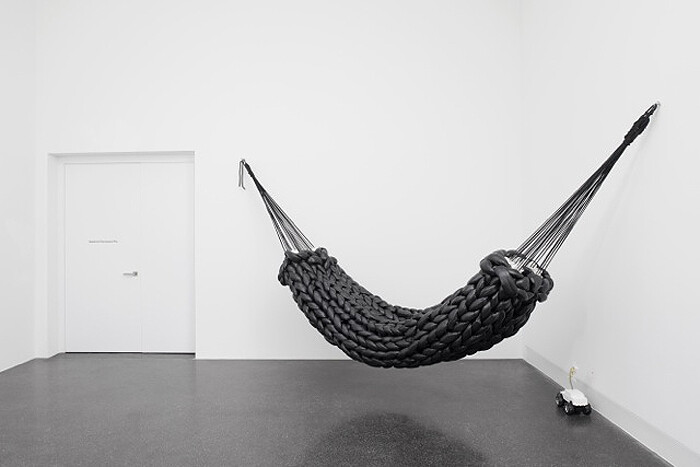“La Demeure Joyeuse II” or “The Happy Home II” is the first show in Francesca Pia’s new space in the Löwenbräuareal, Zürich’s hub for contemporary art. It’s no wonder the mood is optimistic, though the title refers not to this specific setting but to an exhibition of the same name at the Musée des Arts Décoratifs in Paris in 1953 that provided a platform for the textile designs of Paule Marrot in the company of selected friends from the fields of ceramic and interior design. In Zürich, curator Anne Dressen has now gathered some thirty or so artists and designers who cite the domestic or create objects affiliated with domestic space, and in so doing has also queried what role craft plays in art production. At stake here are the relative values of media, skilled craftsmanship, and art (as opposed to design or decoration). Or, on the other hand, can those valuations be ignored to produce a productive tangle of disciplines?
Leisurely domesticity meets workspace at the entrance to the show: the N°28 fat knit hammock (2006) by Bless, formed from oversized woven snakes of fat black polyester and nylon, strung across a corner. This hammock faces the gallery’s front desk, a relatively austere setup of two computers whose numerous trail of cables have been livened up by another Bless production, N°26 Cablejewellery (2005), brightly coloured casings adding ornament to the disarray. In the corner a bolt of Marrot fabric stands ready.
The next passage could be the conceptual porch, a transition from garden to interior where a glorious Betty Woodman vase is spread out on the wall like the petals of its missing bouquet. Ahead are three large galleries stuffed full of textiles, glass, jewellery, wood (and combinations of them all), not to mention three video works. Stephane Barbier Bouvet, a designer who collaborates frequently with artists, is credited with the exhibition’s scenographic design. In the first gallery, several interlocking circular tabletops covered in stretched canvas on crude wooden legs (a form of pedestal repeated in the exhibition) provide the setting for pieces of jewellery under Plexiglas cubes, such as a delicate beaded bracelet, collar, and cuffs from the 1920s by Elsi Giauque. Barbier Bouvet’s set has the effect of moving the frame from a notional home to a museum gift shop, heightening the viewer’s cupidity and possibly dulling their criticality, though there are further riffs on the idea of retail art with Tobias Kaspar’s Wardrobe (2012), which combines a jumper, shirt, and pair of jeans with a c-print on a clothing rail, and a collection of limited editions produced by May magazine.
The remainder of the dizzying show includes early twentieth-century Iranian kilims, masks, icons, decorated dresses, a neat sculptural object for incense burning as the residue of a performance by Fabrice Gygi during the opening, and many mixed-media sculptures before equally diverse wall works. An opposition is inevitable between skilled productions, such as Giauque’s jewellery, and deliberately amateurish works by artists using craft techniques, epitomized by Mai-Thu Perret’s faux Sheep Skin (2012), a greenish imitation in glazed ceramic stretched out solemnly on the floor. The question is, to what end? The press release cites sociologist Richard Sennett’s theses that “making is also thinking,” though Sennett also supports Malcolm Gladwell’s theory that 10,000 hours of practice are required to master a skill. Several artists here are anti-skill maybe because, despite the gift-shop presentation, they are against being subsumed by capital. This show presents not an idealized home but, with so many ideas in play, something akin to the muddle of a real one. Luckily some works fight their way free from that which is decorative and desirable or looks like proudly displayed school pottery: Benjamin Valenza’s Mama loi, Papa loi (2012) is a grisly stage for a conversation piece. In the hands of Valenza, two plastic Henry Massonnet garden chairs have become thrones elevated on plaster bone limbs, scarred with handwritten inscriptions. Lest we think every home is happy, there’s definitely a dark side to be plumbed in a show about the domestic.






